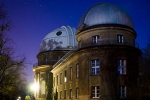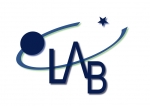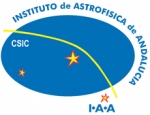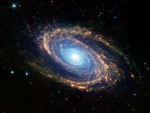Displaying items by tag: astrophysics
Leibniz-Institut für Astrophysik
Leibniz Institute for Astrophysics Potsdam (AIP) is a German research institute.
It is the successor of the Berlin Observatory founded in 1700 and of the Astrophysical Observatory Potsdam (AOP) founded in 1874. The latter was the world's first observatory to emphasize explicitly the research area of astrophysics. The AIP was founded in 1992, in a re-structuring following the German Reunification.
The AIP is privately funded and member of the Leibniz Association. It is located in Babelsberg in the state of Brandenburg, just west of Berlin, though the Einstein Tower solar observatory and the great refractor telescope on Telegrafenberg in Potsdam belong to the AIP.
The key topics of the AIP are cosmic magnetic fields (magnetohydrodynamics) on various scales and extragalactic astrophysics. Astronomical and astrophysical fields studied at the AIP range from solar and stellar physics to stellar and galactic evolution to cosmology.
Kavli Institute for Particle Astrophysics and Cosmology (KIPAC)
The Kavli Institute for Particle Astrophysics and Cosmology (KIPAC) is an independent laboratory of Stanford University, USA.
It aims to to serve as a bridge between the disciplines of astrophysics, cosmology and particle physics. KIPAC's members work in the Physics and Applied Physics Departments on the Stanford campus and at the SLAC National Accelerator Laboratory. Its mission is to bring the resources of modern computational, experimental, observational and theoretical science to bear on our understanding of the universe at large.
KIPAC was founded in 2003 by a gift by Fred Kavli and The Kavli Foundation. It is housed on the grounds of the Stanford Linear Accelerator Center, as well as on the main Stanford campus.
Software: Astrophysics Source Code Library
The Astrophysics Source Code Library (ASCL) is a free on-line registry for source codes of interest to astronomers and astrophysicists, and lists codes which have been used in research that has appeared in, or been submitted to, peer-reviewed publications. ASCL entries are indexed by the SAO/NASA Astrophysics Data System (ADS).
It has been founded in 1999 by Robert Nemiroff and John Wallin, takes an active approach to sharing astrophysical source code. ASCL's editor seeks out both new and old peer-reviewed papers that describe methods or experiments that involve the development or use of source code, and adds entries for the found codes to the library. This approach ensures that source codes are added without requiring authors to actively submit them, resulting in a comprehensive listing that covers a significant number of the astrophysics source codes used in peer-reviewed studies.
[ Copernical note: this product has also a project page on Copenical : ASCL ]
Laboratoire d'Astrophysique de Bordeaux (LAB)
The Laboratory of Astrophysics of Bordeaux (LAB) is a French research centre.
It is a joint research unit of CNRS and the University Bordeaux 1 Science and Technology. It is an integral part of the Aquitanian Observatory for the Sciences of the Universe.
The main missions are :
- international research in the fields of astronomy and astrophysics
- basic and continuing training
- public outreach
The laboratory is composed of researchers and teacher-researchers, engineers, technicians and administrative staff, PhD students and post-docs.
AstroParticle and Cosmology Laboratory - APC
The field of astroparticle physics lies at the interface between the study of the infinitely large and infinitely small, between particle physics and astrophysics.
The AstroParticle and Cosmology laboratory (APC) was designed to bring together the different communities (experimentalists, theorists and observers) involved in this field. It was created in 2005 during the overhaul of the University of Paris 7 on the campus of Paris Rive Gauche with laboratories MPQ (Matériaux et Phénomènes Quantiques) and MSC (Matière et Systèmes Complexes). APC brings together 75 permanent researchers, and over sixty engineers, technicians and administrative staff. Including non permanent staff (PhD students, postdoctoral fellows, visitors), there are some 200 people in this new structure. Besides the University of Paris Diderot, the laboratory funding agencies are CNRS (represented by three of its Institutes: mainly IN2P3, but also INSU and INP), CEA (IRFU) and the Paris Observatory.
Astrophysics Data System (ADS)
The Astrophysics Data System (ADS), developed by NASA, is an online database of over eight million astronomy and physics papers from both peer reviewed and non-peer reviewed sources.
Abstracts are available free online for almost all articles, and full scanned articles are available in Graphics Interchange Format (GIF) and Portable Document Format (PDF) for older articles. New articles have links to electronic versions hosted at the journal's webpage, but these are typically available only by subscription (which most astronomy research facilities have). It is managed by the Harvard–Smithsonian Center for Astrophysics.
Astrophysics Source Code Library (ASCL)
The Astrophysics Source Code Library (ASCL) is a free on-line registry for source codes of interest to astronomers and astrophysicists, and lists codes which have been used in research that has appeared in, or been submitted to, peer-reviewed publications. ASCL entries are indexed by the SAO/NASA Astrophysics Data System (ADS).
Much of scientific progress now hinges on the reliability, falsifiability and reproducibility of computer source codes. Astrophysics in particular is a discipline that today leads other sciences in making useful scientific components freely available online, including data, abstracts, preprints, and fully published papers, yet even today many astrophysics source codes remain hidden from public view.
The Astrophysics Source Code Library (ASCL), founded in 1999 by Robert Nemiroff and John Wallin, takes an active approach to sharing astrophysical source code. ASCL's editors seek out both new and old peer-reviewed papers that describe methods or experiments that involve the development or use of source code, and add entries for the found codes to the library. This approach ensures that source codes are added without requiring authors to actively submit them, resulting in a comprehensive listing that covers a significant number of the astrophysics source codes used in peer-reviewed studies.
The ASCL established an advisory committee in 2011 to provide input and guide its development and expansion. ASCL source codes have been used to generate results published in or submitted to a refereed journal and are available for examination via a download site.
The ASCL is indexed by the SAO/NASA Astrophysics Data System (ADS) and Web of Science's Data Citation Index, and is citable by using the unique ascl number assigned to each code. The ascl number can be used to link to the code entry by prefacing the number with ascl.net (i.e., ascl.net/1201.001).
You can follow the ASCL on our blog, our low-volume Facebook page, on Twitter, or by becoming a member of the ASCL forum and subscribing to it.
Instituto de Astrofísica de Andalucía (IAA-CSIC)
The Instituto de Astrofísica de Andalucía (Institute of Astrophysics of Andalusia, IAA-CSIC) is an astrophysics-related research institute.
It is located in Granada, Andalusia, Spain. IAA activities are related with research in the field of astrophysics, and instrumental development both for telescopes and space missions. Scientific research at the institute covers the following areas:
- solar system;
- star formation, stellar structure and evolution;
- galaxy formation and evolution; and
- cosmology.
The IAA was created as a research institute of the CSIC in July 1975. Presently (in 2012), the IAA operates the Sierra Nevada Observatory. It operates as well the Calar Alto Observatory jointly with the Max-Planck Institute of Heidelberg.
The Instituto de Astrofísica de Andalucía is divided in the following departments:
- Department of Extragalactic Astronomy
- Violent Stellar Formation Group
- AMIGA Group (Analysis of the interstellar Medium of Isolated Galaxies)
- Department of Stellar Physics
- Department of Radio Astronomy and Galactic Structure
- Stellar Systems Group
- Department of Solar System
Astrophysics Research Institute (ARI)
The Astrophysics Research Institute (ARI) is a research centre in astronomy and astrophysics at Liverpool John Moores University (United Kingdom). The institute was formed in 1992.
The Astrophysical Journal
The Astrophysical Journal is a peer-reviewed scientific journal covering astronomy and astrophysics. It was founded in 1895 by the American astronomers George Ellery Hale and James Edward Keeler. It publishes three 500-page issues per month.











